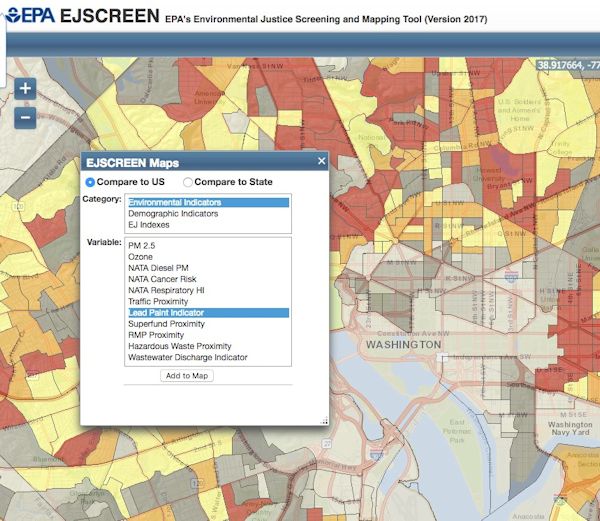SEJournal Online is the digital news magazine of the Society of Environmental Journalists. Learn more about SEJournal Online, including submission, subscription and advertising information.
 |
| A screen shot from the EPA’s environmental justice screening and mapping tool, EJSCREEN, shows percentages of lead paint in metro Washington, D.C. Source: EPA |
TipSheet: EPA Mapping App Helps Find, Deepen Environmental Justice Stories
A recently published government study reminds us that poor and minority people in the United States bear a heavier burden of pollution and the health problems that come with it. That’s a story that’s probably either in or not far from your community.
In 46 of the 50 states, people of color and lower-income people face more air pollution than the rest of the population. The study, published in the American Journal of Public Health, was conducted by a team of scientists from the U.S. Environmental Protection Agency.
The authors focused mainly on fine particulate air pollution using the 2011 National Emissions Inventory and correlating it with Census data. Their findings only further documented a situation that researchers have been telling us about for decades.
Environmental justice — the attempt to address the unequal distribution of environmental health burdens — takes many different forms in many different places.
If you want to report environmental justice stories near you, you might as easily look at lead paint, which is more likely to be poisoning children in the older, deteriorating housing. Or lead in drinking water, which plagues many older urban drinking water systems like the one in Flint, Mich.
But the problems may well be unique to your area and populations. An example is the leftover pollution from past uranium mining on Navajo tribal lands. Or the unincorporated colonias near the U.S.-Mexico border, where running water and sewers are often missing.
EPA tool for discovering environmental justice issues
Beyond your eyes, your ears, your community and your telephone, there is a handy tool that can help you better see environmental justice stories near you: the EPA’s EJSCREEN, an online mapping and screening tool.
It uses the substantial collection of environmental data and indicators EPA regularly collects for air, water and land pollution. Then it overlays them on the federal government’s extensive array of demographic data. The results can be seen in maps and graphs.
EJSCREEN is hardly new, but it has gotten better over time. You can find it here.
One meaningful way to look at the environmental data is by census tract — a neighborhood-level area that includes just a few thousand people. The EJSCREEN app takes demographic data from the Census Bureau’s American Community Survey, which includes data on things like housing, as well as income, ethnicity, language and other variables.
The app can be a tool for exploration and discovery (just as can walking around and talking to people). You can pick an area of particular interest and get a report of many environmental indicators, which may show you which ones are of most concern. It can tell you the age of the housing stock, or proximity to a Superfund hazardous waste site.
And even though environmental justice may have fallen on hard times at EPA under the Trump-Pruitt administration, support for users of the app is still there. EPA offers occasional webinars to help people learn how to use EJSCREEN and understand results. The app’s web page includes links to a number of other EPA data mapping tools. For the true geeks, it allows you to download the raw data behind the online app.
The strength of the tool is partly the strength of EPA’s vast collection of environmental data. But it is important to understand the limits and weaknesses of EPA data as well. It is never wise for a reporter to rely on data without doing whatever possible to check it against ground truth.
Remember that data tools are really only part of the much larger journalistic toolset — a starting point for reporting, not a substitute for it.
* From the weekly news magazine SEJournal Online, Vol. 3, No. 10. Content from each new issue of SEJournal Online is available to the public via the SEJournal Online main page. Subscribe to the e-newsletter here. And see past issues of the SEJournal archived here.













 Advertisement
Advertisement 



